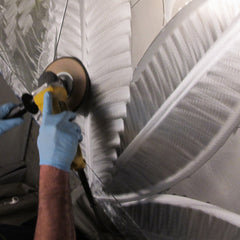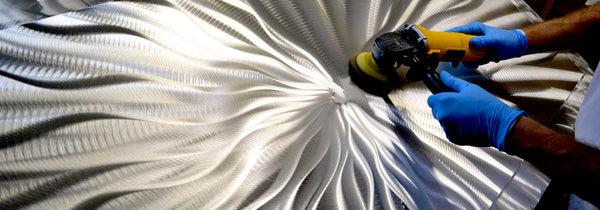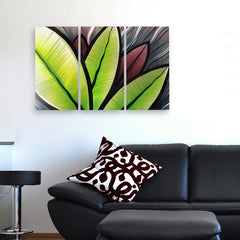The Creative Process
The Creative Process behind our amazing large metal wall art and wall sculptures!

Polishing and Sanding the Metal Surface
After selecting the proper aluminum alloy sheet material, the metal is prepped to remove any contaminants. Then piece's design is created by skillful sanding and polishing the metal surface to create texture, depth, and reflective quality.

Hand Applied Color
Color is carefully layered over the metal surface with various application techniques, and fine details are added to complete the vibrant color scheme of the piece using specialized transparent paints, dyes, and inks. A protective clear coating is then applied to seal the layers and create a deep lustrous appearance.
Finished Art Piece
After the art has cured, it is complete and ready to go on the wall! Our art is made to order, so every piece is made fresh upon payment and shipped immediately. See some more examples of finished art in our gallery.
Every artist has their own style and process when it comes to how to make metal wall art. Our featured studio artist, Brian Jones - shares some insight with us on how he goes about crafting his metal wall art designs.
Conception of the art piece:
From imagination to a finished piece of art, often times dozens of hours will be spent in preparation. Composition, feel, design, and color are some of the key factors in bringing starting ideas to life on the finished metal canvas. Working from over twenty years of experience in fine art, Brian draws from many resources for the inspiration for his work. Some pieces spring from his love for nature and the outdoors, others from his interests in graphic design, print, and technology. This often plays out as modern art look with a natural and elemental feel. He begins originating his concepts using many techniques, including graphic sketches, illustrations and CAD (computer aided design), as well as meditative practices. After a composing a particular design for further development, he begins carefully cultivating the concept and selecting metal materials.
Materials Used to Make Metal Wall Art:
According to Brian, “as artists, ultimately the true quality of our creations are only as good as the foundations we incorporate into their making” So it is safe to say he believes in using only the absolute best materials and supplies in his work. Decades of research and go into the selection of metals, paints, adhesives, bases, brackets, and packaging materials used to craft his artwork. Only top quality materials from industry leading suppliers are utilized, to ensure consistent aesthetic and physical quality. These can range from aluminum and steel to brass and copper sheet metal, depending on the piece.
Dimension & Size of the Art Piece:
After the design concepts are realized they come to the next stage of development - planning the format of the metal art piece. Brian believes in the mantra that practice makes perfect. He often spends over sixty hours a week in his studios, refining his craft and bringing ideas to reality. Materials, paints, and tools are carefully chosen and the process begins. Brian will often mock up several display areas to test each design – using many different lighting types, mounting orientations, and perspectives, to ensure his intended visual concept is ultimately conveyed. Depending on the display locations, some pieces are tested for extended periods of time in outdoor conditions to ensure quality and UV protection.
Sanding and Grinding the Wall Art:
Brian selects specific aluminum alloys which are matched to his intended use. These metals are chosen for their highly reflective nature and light weight, as well as the ability to be machined and be molded into many shapes. The majority of Brian’s pieces are made by precise grinding and sanding of the metal to create stunning, holographic impressions in the surface – a process he calls “texturing”. This gives depth, and displays amazing movements and reflections of light across the artwork as you move around it! Countless grinding tools, sanding disks, and one-of-a-kind handmade specialty tools are used to produce the unique look and style of his artwork. Some works are hand bent and formed over special dies made by Brian himself. Many of his contemporary designs also incorporate extremely detailed CNC cutting work, again all designed and produced exclusively by Brian in his digital studio.
Adding Color to Metal Wall Art:
Brian creates one of a kind color mixes to make his color pallets - the paint he uses is completely unique, and not used by any other artist in the world. With a background in custom paint and metal fabrication, Brian has had the opportunity to work with hundreds of paints, dyes, and inks, mixing processes, and application techniques. Airbrushing, hand application, and other special processes are used to colorize his metal art with spectacular semi-transparent paints, also known as candy finishes. Brian uses the same high-tech quality products applied to show vehicles in the automotive industry to color much of his wall art. Applied in layers, the paint application process can take days to complete on each metal piece created. This allows for the detailed grinding patterns to be viewed underneath, giving immense depth and perspective to his works.
Assembling the Finished Panels and Parts:
The quality of each piece is the top priority for Brian when designing how separate parts and metal panels go together. On some pieces, multiple sections of the art are assembled in layers to create the desired depth and dimension. Brian has developed a proprietary connecting system for his multidimensional art, allowing the metal parts to be mechanically linked together with amazing strength and rigidity. For other applications where depth, layering, or hanging components are used, industrial strength adhesives and 3M automotive grade branded tapes are used to attach parts together. In all cases, Brian tests, and re-tests his designs to ensure the absolute best performance of his art assembly for many years to come.
Clear Coat Protection: Brian understands that great piece of art deserves the proper protection to keep it looking new for many years to come. No expense is spared doing just that, as his metal art is covered with multi-layered coatings of scratch and UV protective clear coat applied in a state of the art process. Some pieces use other finishing techniques, such as natural metal finishes, intentional rusted or corrosion finishes, etc. and clear coating is not necessary or possible. In the description area of each piece on our website, you will see if the art has clear coat applied.
Signing, Dating, and Certifying the Metal Art Piece:
Once fully assembled, Brian meticulously checks each one of a kind piece he creates to ensure the quality and craftsmanship. He then signs and dates, and approves it for sale in our galleries. A certificate of authenticity is created, indicating a genuine original by Brian M Jones, and signed off by the artist. This documentation will be sent along with the piece to the collector for their records.



